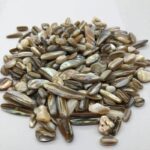Quartz is one of the most common minerals on Earth, and it is found in a wide variety of geological settings. It is a hard, crystalline mineral with a glassy luster, and it is often colorless or white. However, quartz can also be found in a variety of colors, including pink, purple, yellow, and green.

There are several ways to identify quartz. One way is to look at its physical properties. Quartz is a hard mineral, with a Mohs hardness of 7. This means that it can scratch glass. Quartz also has a glassy luster, which means that it reflects light in a way that makes it look like glass.
Another way to identify quartz is to look at its crystal structure. Quartz crystals are typically hexagonal, with six sides. Quartz crystals can also be found in a variety of other shapes, including pyramidal, prismatic, and massive.
Quartz is a piezoelectric material, which means that it can generate an electrical charge when it is subjected to mechanical stress. This property makes quartz useful in a variety of electronic applications, such as oscillators, filters, and sensors.
Physical Properties of Quartz
- Hardness: 7 on the Mohs scale
- Luster: Glassy
- Color: Colorless, white, pink, purple, yellow, green
- Crystal structure: Hexagonal
Uses of Quartz
Quartz is used in a wide variety of applications, including:
- Jewelry: Quartz is a popular gemstone, and it is often used in jewelry.
- Electronics: Quartz is used in a variety of electronic applications, such as oscillators, filters, and sensors.
- Glassmaking: Quartz is used in the manufacture of glass.
- Ceramics: Quartz is used in the manufacture of ceramics.
- Construction: Quartz is used in the construction of roads, buildings, and other structures.
How to Identify Quartz
There are several ways to identify quartz, including:
- Look at its physical properties. Quartz is a hard mineral, with a Mohs hardness of 7. It also has a glassy luster.
- Look at its crystal structure. Quartz crystals are typically hexagonal, with six sides.
- Look at its color. Quartz can be colorless, white, pink, purple, yellow, or green.
- Test its piezoelectric properties. Quartz is a piezoelectric material, which means that it can generate an electrical charge when it is subjected to mechanical stress.
Common Mistakes to Avoid When Identifying Quartz
There are several common mistakes that people make when identifying quartz. These mistakes include:
- Mistaking quartz for other minerals. Quartz can be mistaken for a variety of other minerals, such as calcite, feldspar, and glass.
- Mistaking quartz for a diamond. Quartz is sometimes mistaken for a diamond because it is a hard, colorless mineral with a glassy luster. However, quartz is not as hard as a diamond, and it does not have the same refractive index.
- Confusing quartz with other types of quartz. There are several different types of quartz, including amethyst, citrine, and rose quartz. These different types of quartz can have different colors and properties.
Conclusion
Quartz is a common mineral with a wide variety of uses. It is a hard, crystalline mineral with a glassy luster. Quartz can be colorless, white, pink, purple, yellow, or green. Quartz is used in a variety of applications, including jewelry, electronics, glassmaking, ceramics, and construction.




























